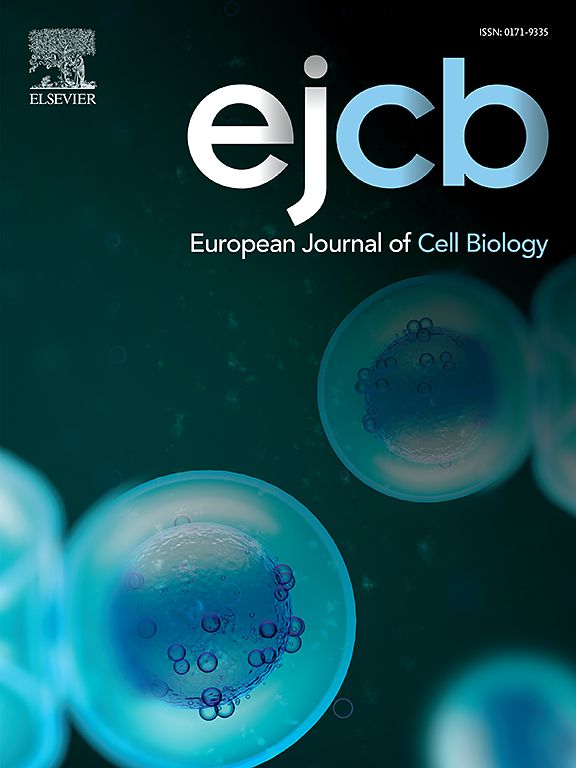肌球蛋白抑制通过sirt1 - nfat介导的H3K9me3修饰增强心肌细胞周期活性
IF 4.3
3区 生物学
Q2 CELL BIOLOGY
引用次数: 0
摘要
成年哺乳动物心脏的再生能力有限,主要是由于心肌细胞的细胞周期活性较低。实现心肌细胞分裂是一项具有挑战性的任务,因为心肌细胞的主要特征收缩功能与细胞周期进程并不完全相容。为了分析心肌细胞肌体收缩与增殖之间的关系,我们使用了Blebbistatin (Blebb),一种常用的肌球蛋白II抑制剂,用于体外培养心肌细胞,发现Blebb在心肌细胞中抑制肌球蛋白导致细胞周期进入增强,细胞分裂失败,从而增加多倍体。研究发现,Blebb诱导的细胞周期进入增加需要H3K9me3修饰的升高,并且增加的H3K9me3修饰富集在编码细胞周期负调节因子并受NFAT转录因子控制的基因上。此外,SIRT1被鉴定为一种核细胞质穿梭蛋白,可在肌球蛋白抑制下从肉瘤的Z系解离并转运到细胞核中,直接与NFATc3相互作用,并且是blebb诱导的H3K9me3修饰和细胞周期活性升高所必需的。我们的研究结果发现了一个信号通路,将肌肉信号转导到调节心肌细胞周期的表观遗传修饰,这可能有助于理解控制心肌细胞增殖的复杂调控网络,并为再生医学提供治疗靶点。本文章由计算机程序翻译,如有差异,请以英文原文为准。
Myosin inhibition enhances cardiomyocyte cell cycle activity through SIRT1-NFAT-mediated H3K9me3 modification
The limited regenerative capacity in adult mammalian heart is mainly attributed to the low cell cycle activity of cardiomyocytes. Achieving cardiomyocyte division is a challenging undertaking, as the contractile function, a major characteristic of cardiomyocytes, is not overall compatible with cell cycle progression. To dissect the relationship between sarcomeric contraction and proliferation in cardiomyocytes, we utilized Blebbistatin (Blebb), a Myosin II inhibitor commonly used for cardiomyocyte culture ex vivo, and revealed that Myosin inhibition by Blebb in cardiomyocytes resulted in enhanced cell cycle entry with cytokinesis failure, thus increasing polyploidy. Elevated H3K9me3 modification was found to be required for the increased cell cycle entry induced by Blebb, and the increased H3K9me3 modifications were enriched on genes that encode negative regulators of cell cycle and controlled by NFAT transcription factors. Furthermore, SIRT1 was identified to be a nucleocytoplasmic shuttling protein that dissociates from Z lines of sarcomeres and translocates into the nucleus upon Myosin inhibition, directly interacts with NFATc3, and is required for the Blebb-induced elevation of H3K9me3 modification and cell cycle activity. Our results identified a signaling pathway transducing sarcomeric signals to epigenetic modifications modulating the cardiomyocyte cell cycle, which may facilitate the understanding of the complex regulatory network controlling cardiomyocyte proliferation and provide therapeutic targets for regenerative medicine.
求助全文
通过发布文献求助,成功后即可免费获取论文全文。
去求助
来源期刊

European journal of cell biology
生物-细胞生物学
CiteScore
7.30
自引率
1.50%
发文量
80
审稿时长
38 days
期刊介绍:
The European Journal of Cell Biology, a journal of experimental cell investigation, publishes reviews, original articles and short communications on the structure, function and macromolecular organization of cells and cell components. Contributions focusing on cellular dynamics, motility and differentiation, particularly if related to cellular biochemistry, molecular biology, immunology, neurobiology, and developmental biology are encouraged. Manuscripts describing significant technical advances are also welcome. In addition, papers dealing with biomedical issues of general interest to cell biologists will be published. Contributions addressing cell biological problems in prokaryotes and plants are also welcome.
 求助内容:
求助内容: 应助结果提醒方式:
应助结果提醒方式:


